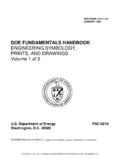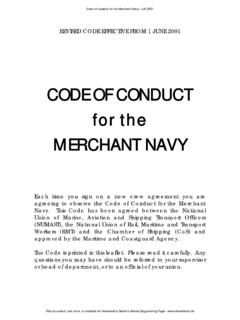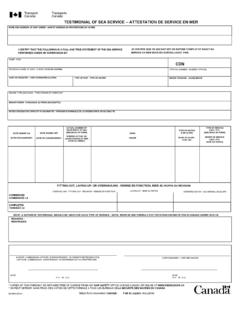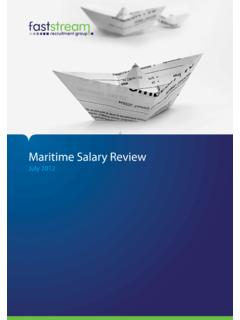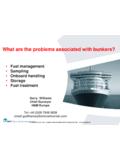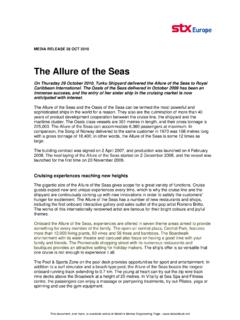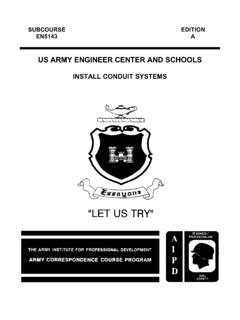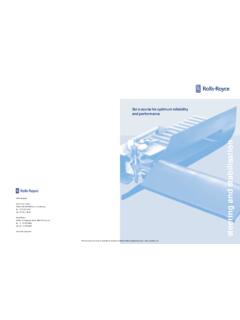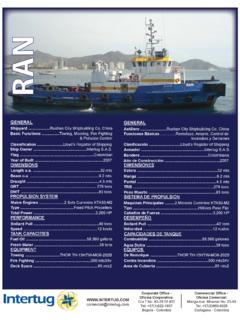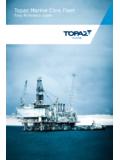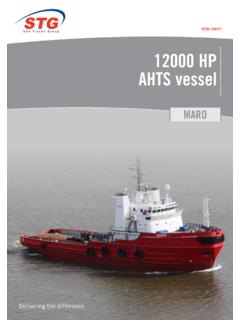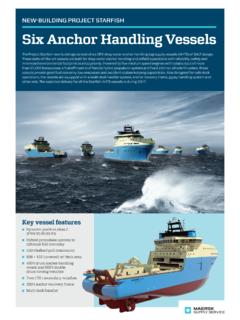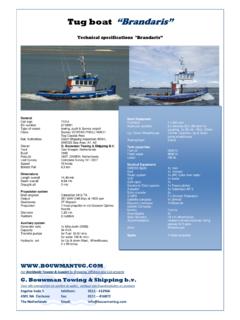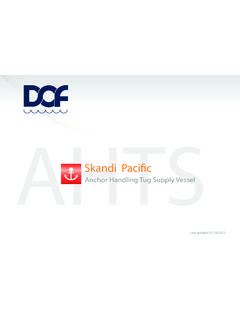Transcription of Bollard Pull - dieselduck
1 Bollard pull (Capt. P. Zahalka, Association of Hanseatic Marine Underwriters) Bollard pull is, the tractive force of a tug, expressed in metric tonnes (t) or kN. This figure is not accurately determinable by mathematical methods, therefore it must be evaluated for each tug by a Bollard pull - Test . Although primarily dependent on the tug s engine output expressed in BHP (Break Horse Power or MCR (Maximum Continuous Rating) or DIN 6270, output "A"), also some other factors, like: - propeller-type - kort nozzle (yes/no) - shape of the hulls submerged part - draught - trim become important regarding the achievable the Bollard pull . As a rules of thumb for an approximately conversion from BHP to "t" of the effective available Bollard pull the following formulas may apply: Tug equipped with fixed pitch propeller: (freewheeling) BHP x 0,9 x 1,10 / 100 = (t) Tug equipped with fixed pitch propeller and kort-nozzle: BHP x 0,9 x 1,20 / 100 = (t) Tug equipped with controllable pitch propeller: (freewheeling) BHP x 0,9 x 1,25 / 100 = (t) Tug equipped with controllable pitch propeller and kort-nozzle : BHP x 0,9 x 1,40 / 100 = (t) The resulting values have to be regarded as rough estimates and might be variable, depending on parameters of ship s construction.
2 Nowadays this applies all the more as there is a variety of different types of propulsion systems which might provide different amounts of Bollard pull defiant of equal engine performance. In general the Bollard pull - Test is carried out by steaming into a towrope which is fixed ashore and connected to a measuring device, successively with three different performance-level (80%, 100% and overload = 110%). Very important fort the performance of the Bollard pull - Test is the location. A sufficient sized tideless sheet of water with a depth of not less than 20m is needed. The length of the towrope is also Seite 1 von 10 This document, and more, is available for download from Martin's Marine Engineering Page - essential because the propeller stream has to develop without interference by reflection at the quaywall. The achieved traction force is described as the Continuous Bollard pull and has to differentiated from the so called Static Bollard pull .
3 Continuous Bollard PullStatic Bollard PullPeriodeBollard pull Seite 2 von 10 This document, and more, is available for download from Martin's Marine Engineering Page - The Static Bollard pull also called Maximum Bollard pull is achieved shortly after the commencement of the Test, when the Propeller is working in still water and full power is achievable. Once the water is streaming through the propeller the performance decreases to the effect of cavitation and propeller slip. The remaining traction force is named Continuous Bollard pull or also Steady Bollard pull and is measured for a period of about 10 minutes. The result of the achieved traction force of the tug at different performance-levels of propulsion will be certified and an of Bollard pull certificate will be issued. In general the testing institution is the classification society of the vessel. : Seite 3 von 10 This document, and more, is available for download from Martin's Marine Engineering Page - Detailed information could be learned from the record of the test if required.
4 It is not difficult to imagine that these figures are idealized. In practise following losses have to be borne in mind: 1) During a tow it is not possible to maintain 100% power of the main engine for a long period without a development of thermal problems. Therefore it makes sense to take the nominated BHP (Break Horse Power or MCR (Maximum Continuous Rating) or DIN 6270, output A ) of the tug in consideration at 90% only . 2) Keeping in mind that Bollard pull test results have been determined at 0 speed of the tug, it is understandable, that these results wouldn t have been attained on a tug which would make some speed through the water on his own. Every speed made (and thereby overcoming hydro- and aerodynamic resistance) will consume energy or engine power. In other words: For the achievement of Bollard pull on a vessel making speed through the water on her own, always only as much power is at disposal as is not needed for making this speed.
5 "0" Speed through Water = 100% Bollard pull max. Speed through Water = "0" Bollard pull The following curve shows, in adequate precision, tugs own speed related to possible Bollard pull . 3) Other factors affecting the development of Bollard pull in a harmful way are: - Roughness of the underwater body of the tug (marine fouling), - pitching, rolling and heaving of the Tug (sea conditions), - high seawater temperature (ME- cooling water problems) Seite 4 von 10 This document, and more, is available for download from Martin's Marine Engineering Page - For the process to determine the necessary Bollard pull for a specific towing task the above restrictions have to be kept in mind. We have now arrived at the following question: How much Bollard pull is necessary? Surely this is one of the most interesting questions in connection with this matter, but also one difficult to answer, too. The Bollard pull in conjunction with a specific object to be towed must be assessed to: obtain the pre-planed towing-speed, provide sufficient power-reserve to ensure safety of the tow also in unfavourable current- and weather conditions.
6 So, sufficient energy must be provided to overcome the resistance occurring at a swimming body making speed through water. This resistance is made up of several components: Simplified these aret: 1) Hydrodynamic resistance at the Vessel at the towing gear 2) Aerodynamic resistance at the vessel This two values are in turn depending on other parameters as sea state, wind direction, wind speed, size of the topside facing vertical to the wind direction, yawing and pitching of the object, towing speed through water, roughness of the underwater body, size and amount of propeller, etc. To estimate the necessary value of Bollard pull several rules of thumbs exists, which all have an empirical history. For this purpose the VHT uses a self developed calculation scheme which includes both empirical as pure mathematical/physical components.
7 This scheme provides values which have been approved in practice and still include a reasonable safety margin. See the following example: Seite 5 von 10 This document, and more, is available for download from Martin's Marine Engineering Page - Calculation of the required Bollard pull to tow ship shaped Verschleppung von schiffsf rmigen Anh ngen ANNEX: MS Example Type: Container length (L) 160,00 m length (Lpp) 151,00 m width (B) 17,20 m Superstructure height (Ah) 12,00 m ) Bear in mind superstructure length (Al) 130,00 m ) possible Superstructure width (Ab) 15,00 m ) Deck load Height (main deck-lower keel) (Sh) 15,00 m draught (T) 8,20 m or 26,90 ft Displacement, seawater ,00 to Displacement/Volume (D)
8 ,63 cbm Block-Coefficient (a) 0,63 wetted submerged area (S) ,39 qm or ,41 qft propeller diameter 4,00 m or 13,12 ft number of propeller 1,00 yawing-angle (b) 5,00 wind-angle (g) 25,00 (enter 0 -180 ) wind-speed (Vw) 5,00 BFT.
9 Without air stream 20,79 kn 10,69 m/sec incl. air stream 25,79 kn 13,27 m/sec air density 1,22 kg/cbm Shape-Coefficient (hull) 1,00 Shape-Coefficient (superstructure/cargo) 1,20 Vertical area facing the wind ,71 qm Day since last dry-docking 150,00 Tage Sea margin 0,15 see ====>> Speed over ground 5,00 kn 2,57 m/sec Stream ( - if following) 0,50 kn 0,26 m/sec Speed through water (v) 5,50 kn 2,83 m/sec hydrodynamic towing resistance (Rh) 20,22 to aerodynamic towing resistance (Ra) 15,55 to (following) friction due to fouling (Rf) 5,50 to Hydrodynamic resistance of Towing gear (Rg) 0,50 to (lump) Calculated total - towing resistance of tow (Rt) 41,77 to To achieve at gale force: 5,00 BFT the theoretical towing speed (v) of: 5,50 kts through water, the certified Bollard pull (BP) of the Tug at 100% Engine Power must be 46,00 tonnes equal to BHP-need of: ,00 BHP (about) Tugs standard cruising speed (v2): 14,00 kts It is recommended to use a tug with a certified Bollard pull of: 50,00 tonnes.
10 Seite 6 von 10 This document, and more, is available for download from Martin's Marine Engineering Page - You will have noted that we regard the calculated total resistance to be equal to 90 % of the necessary towing force and thus ascertain the required certified Bollard pull at 100% Engine Power as follows: 00,461009077,41= Classification societies, also issuing Towage Approval Certificates, are dealing with this problem as follows: Germanischer Lloyd: Quote The towing force is to be ascertained with due allowance for the tow, the route, the duration of the voyage and the weather and sea state proper to the time of the year. A general reference may be taken as the power by which a tug is able to keep the tow in position with ahead wind of v = 20 m/s = Bft. 8-9 and a head current of v = 1 m/s. (This reference value is not to be interpreted to mean that a tug and tow drifting astern under the effect of higher winds and wave drifting forces in the open sea is exposed to danger.)
